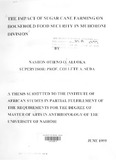| dc.description.abstract | This study was undertaken to understand the interplay between sugarcane farming In
Muhoroni and the situation of household food security in the area. In effect it sought to
demonstrate how the dominance of the contractual cane farming in the area affects household
subsistence in the region and at the end offer perspectives on how these production systems
could be reconciled for sustainable human development.
In respect to rural agricultural development, the establishment of sugar schemes in Western
Kenya over the years is seen as a significant contribution to the attainment of self-sufficiency
in sugar for domestic market and also improvement in rural per capita income. Nonetheless
the issue of food security in these regions has attracted little intervention from the
development stakeholders, including the government.
The presence of large sugarcane farms holding much of the land in Muhoroni and the
temptation of living on food purchases from the open market were among the reasons
presenting the need for this study. The overriding assumption here was that these sugarcane
farmers have been attracted to the cash crop at the expense of their own food needs.
The research into this problem was carried out in the Muhoroni sugar belt for four months. A reconnaissance and the pre-test of the research instrument preceded the data collection which
covered 150 households drawn from a random sample of the population. The data was
gathered using an interview schedule or questionnaire, unstructured interviews and
Observation methods.
This was followed up by a later study, which targeted the management of the sugar firms,
farmers' co-operatives and divisional government representatives. The data was then analysed
using the SPSS computer package in order to measure the relationships occurring in the study.
The hypotheses employed in this research related to the spread of modern crop technology in
Muhoroni, use of sugarcane earnings, women's financial empowerment and the issue of
wildlife and food issues in the area. It emerged from the study that modern farming methods relevant to subsistence agriculture have penetrated subsistence farming in Muhoroni. Many of
these facilities, for example, the use of fertilisers, are shared directly between the two farming
systems. Generally their use was seen as a factor of local limitations such as farm sizes,
education and affordability rather than sugarcane farming.
This study affirmed that sugarcane earnings are the main source of livelihood to the people of
Muhoroni. However, these incomes are received in one lump sum after a very long time
(sometimes taking up to 3 years) and were often a target of expensive purchases and spending.
Most households lack elementary accounting skills and fiscal planning and these leads to their
decapitalization within very short time of the harvest. The farmers' co-operatives in the area
are decayed and their functional capacities limited.
Although it is women who mainly provided the farm household with reproductive labour in
addition to active labour participation in subsistence and sugarcane production, the study
showed that they are least compensated for their effort. Women's access to sugarcane pay- off
is paltry: largely in the form of cash remittances from their husbands who are the registered
holders of the land title deeds. More women lack savings and credit facilities compared to
their male counterparts and mainly depend on small-scale business and social support
networks for certain specific development initiatives. This has led to the mushrooming of
numerous income generating women groups in the area, most of which engage in sugarcane
growing on leased farms.
Finally, wildlife is a big constraint to food cropping in the area cannot be overstated. Ninety
percent of the respondents decried the destruction of food crops by wildlife of various species,
which are harboured in the sugarcane populations.
In the last chapter, several recommendations have been suggested as to how both food and
sugarcane production in Kenya can be enhanced through an integrated farming approach.
Some of these include the revitalisation and strengthening of agricultural extension and
veterinary services in the area, rationalisation of food policy and pricing mechanisms to make
food cropping profitable and attractive to farmers and institutional capacity building for the
social networks and marketing agencies in the area.
In addition, there is need to institute better Sugar production and marketing policies, which
protect the domestic farmers against harsh trade realities which set in following the
liberalisation tendencies of the national economy. At the same time, potential conflicts
between wild game hibernating in the sugarcane farms and food farming should be addressed.
The sum effect of a successful implementation of these considerations is bound to boost the
attainment of sustainable development in the cane growing areas of Kenya. | en |

